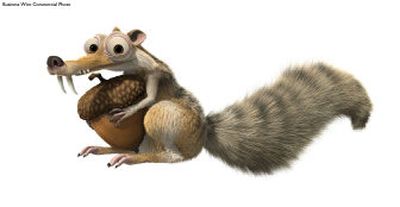Modern animation enters ‘Ice Age’

During a bus trip to the Alaskan set of a 1983 Disney live-action movie, I got into a conversation about the declining status of animated movies and boldly predicted to the Disney executive sitting next to me that the genre was about to become extinct.
For a while, I was a sage.
Not a single animated feature was released in the U.S. in 1984, and the five released in 1985 sold less than $50 million worth of tickets combined.
Then, in a blur of blockbusters that began with “Who Framed Roger Rabbit” (1988), we saw Disney’s resuscitated animation division churn out the instant classics “The Little Mermaid” (1989), “Beauty and the Beast” (1991), “Aladdin” (1992), and “The Lion King” (1994), followed by Pixar’s first soldier in the computer-animation revolution, “Toy Story.”
In 2001, 10 years after “Beauty and the Beast” became the one and only animated movie ever nominated for Best Picture, the Academy decided to give the animated feature its own category. The first winner: “Shrek.”
How healthy are animated movies today? Well, in 2004, the top five animated films sold more than $1.1 billion worth of tickets in the U.S. and Canada. The three films nominated for Best Animated Feature that year outgrossed the five live-action nominees, $858.6 million to $401.5 million.
And in 2006, 22 years after the shutout of ‘84, the major studios, along with the new Weinstein Co., plan the wide release of at least 14 new animated features. “Hoodwinked” and “Doogal” have already been released, and animation’s first box-office sure thing — “Ice Age 2: The Meltdown” — opens Friday.
Where heads were down two decades ago, people in animation today are as cheery as investors in a bull market.
“I think people will look back at this period as the Golden Age of animation,” says Yair Landau, vice chairman of Sony Pictures Entertainment, whose animation division will release its first in-house computer-animated feature (“Open Season”) in September. “There used to be one studio putting out animated product; now, there are multiple entities.”
IDT Entertainment is one of several new independent companies dedicated to computer animation. Its first feature — “Everyone’s Hero” — will be released by Fox in September.
“This is a very exciting time,” says Janet Healy, IDT’s president of animation. “I feel like we’re at a moment where we’re reinventing the medium again.”
Healy has been at the forefront of every major technical breakthrough in the last 20 years. She worked for George Lucas’ Industrial Light & Magic, then worked on computer animation at Disney, and followed its animation guru, Jeffrey Katzenberg, to DreamWorks.
She says the big change driving the current boom in animation is the breakdown in resistance of veteran animators to the new computer technology.
“Technology is not even a discussion anymore,” she says. “We have enough qualified, off-the-shelf software and fast machines to tell whatever story we want. Whatever images we imagine, we know we can make.”
While computer animation dominates the field, it’s not the only medium. None of last year’s Oscar nominees were computer-animated. The Oscar winner, “Wallace & Gromit: The Curse of the Were-Rabbit,” and Tim Burton’s “Corpse Bride” were done with models and stop-motion. The third nominee, Hayao Miyazaki’s “Howl’s Moving Castle,” was traditional hand-drawn cell animation.
This year, we’ll see two movies — “Monster House” and “A Scanner Darkly” — where the computer animation is done over live-action performances, creating images that are both cartoonish and photorealistic.
But, as virtually everyone interviewed for this story agrees, the medium is not the message — the message is.
“Pixar’s CG is fantastic, but their movies work because they know how to tell stories,” says Spaz Williams, who directed the upcoming “The Wild.” “Look at ‘South Park.’ It’s the worst animation technique in the world, but the stories are great.”
One reason animated movies have a higher ratio of successes to failures than live-action features is the way they’re made.
“We have a longer window to get it right,” says John Davis, whose first animated feature, “Jimmy Neutron: Boy Genius,” was among the inaugural slate of Oscar nominees in 2001. “We sketch out scenes and can see how they work before we commit to them. And we can go back and fiddle with them.”
On a live-action film, you have actors for a certain number of days, and what you get is what you have to work with. With voice actors for animated movies, they can come back whenever they’ve got the time. If they can’t come to you, you can go to them.
“I went to Taos (N.M.) to record Julia Roberts,” says Davis of one of his voice cast for this year’s “The Ant Bully.”
As you scan the list of animated movies opening this year, you’re struck by the star wattage of their casts.
“It’s great fun for the actors,” says Sandra Rabins, who heads Sony Pictures Animation. “It doesn’t take a lot of time. They don’t have to go through hair and makeup and sit around waiting for lighting.”
Charles Solomon, an author, journalist and animation expert, knows all the cycles of animation’s history and says the only thing new today is the technology.
“I’m just old-fashioned enough to think that good stories are what makes good animation movies,” he says. “And good animated movies stay on the shelves forever.”
As for Arlene Ludwig, the Disney exec to whom I foolishly predicted the end of animation all those years ago, she refuses to gloat.
“I knew you’d come around,” she laughed when I called to offer a long overdue retraction.